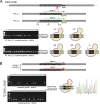Plasmid-Based CRISPR-Cas9 Gene Editing in Multiple Candida Species
- PMID: 30867327
- PMCID: PMC6416365
- DOI: 10.1128/mSphere.00125-19
Plasmid-Based CRISPR-Cas9 Gene Editing in Multiple Candida Species
Erratum in
-
Correction for Lombardi et al., "Plasmid-Based CRISPR-Cas9 Gene Editing in Multiple Candida Species".mSphere. 2020 Jun 10;5(3):e00494-20. doi: 10.1128/mSphere.00494-20. mSphere. 2020. PMID: 32522782 Free PMC article. No abstract available.
Abstract
Many Candida species that cause infection have diploid genomes and do not undergo classical meiosis. The application of clustered regularly interspaced short palindromic repeat-Cas9 (CRISPR-Cas9) gene editing systems has therefore greatly facilitated the generation of gene disruptions and the introduction of specific polymorphisms. However, CRISPR methods are not yet available for all Candida species. We describe here an adaption of a previously developed CRISPR system in Candida parapsilosis that uses an autonomously replicating plasmid. Guide RNAs can be introduced in a single cloning step and are released by cleavage between a tRNA and a ribozyme. The plasmid also contains CAS9 and a selectable nourseothricin SAT1 marker. It can be used for markerless editing in C. parapsilosis, C. orthopsilosis, and C. metapsilosis We also show that CRISPR can easily be used to introduce molecular barcodes and to reintroduce wild-type sequences into edited strains. Heterozygous mutations can be generated, either by careful selection of the distance between the polymorphism and the Cas9 cut site or by providing two different repair templates at the same time. In addition, we have constructed a different autonomously replicating plasmid for CRISPR-Cas9 editing in Candida tropicalis We show that editing can easily be carried out in multiple C. tropicalis isolates. Nonhomologous end joining (NHEJ) repair occurs at a high level in C. metapsilosis and C. tropicalisIMPORTANCECandida species are a major cause of infection worldwide. The species associated with infection vary with geographical location and with patient population. Infection with Candida tropicalis is particularly common in South America and Asia, and Candida parapsilosis infections are more common in the very young. Molecular methods for manipulating the genomes of these species are still lacking. We describe a simple and efficient CRISPR-based gene editing system that can be applied in the C. parapsilosis species group, including the sister species Candida orthopsilosis and Candida metapsilosis We have also constructed a separate system for gene editing in C. tropicalis.
Keywords: CRISPR; Candida; genome editing.
Copyright © 2019 Lombardi et al.
Figures





Similar articles
-
Gene editing in clinical isolates of Candida parapsilosis using CRISPR/Cas9.Sci Rep. 2017 Aug 14;7(1):8051. doi: 10.1038/s41598-017-08500-1. Sci Rep. 2017. PMID: 28808289 Free PMC article.
-
Plasmid-Based CRISPR-Cas9 Editing in Multiple Candida Species.Methods Mol Biol. 2022;2542:13-40. doi: 10.1007/978-1-0716-2549-1_2. Methods Mol Biol. 2022. PMID: 36008654
-
A CRISPR-Cas9 system for multiple genome editing and pathway assembly in Candida tropicalis.Biotechnol Bioeng. 2020 Feb;117(2):531-542. doi: 10.1002/bit.27207. Epub 2019 Nov 28. Biotechnol Bioeng. 2020. PMID: 31654413
-
CRISPR/Cas9-mediated correction of human genetic disease.Sci China Life Sci. 2017 May;60(5):447-457. doi: 10.1007/s11427-017-9032-4. Epub 2017 May 3. Sci China Life Sci. 2017. PMID: 28534256 Review.
-
Strategies for Applying Nonhomologous End Joining-Mediated Genome Editing in Prokaryotes.ACS Synth Biol. 2019 Oct 18;8(10):2194-2202. doi: 10.1021/acssynbio.9b00179. Epub 2019 Sep 26. ACS Synth Biol. 2019. PMID: 31525995 Review.
Cited by
-
Role of CpALS4790 and CpALS0660 in Candida parapsilosis Virulence: Evidence from a Murine Model of Vaginal Candidiasis.J Fungi (Basel). 2020 Jun 12;6(2):86. doi: 10.3390/jof6020086. J Fungi (Basel). 2020. PMID: 32545584 Free PMC article.
-
Probing gene function in Candida albicans wild-type strains by Cas9-facilitated one-step integration of two dominant selection markers: a systematic analysis of recombination events at the target locus.mSphere. 2024 Jul 30;9(7):e0038824. doi: 10.1128/msphere.00388-24. Epub 2024 Jun 28. mSphere. 2024. PMID: 38940507 Free PMC article.
-
The Pathogenic Yeast Candida parapsilosis Forms Pseudohyphae through Different Signaling Pathways Depending on the Available Carbon Source.mSphere. 2022 Jun 29;7(3):e0002922. doi: 10.1128/msphere.00029-22. Epub 2022 May 9. mSphere. 2022. PMID: 35766504 Free PMC article.
-
Population genomics of the pathogenic yeast Candida tropicalis identifies hybrid isolates in environmental samples.PLoS Pathog. 2021 Mar 31;17(3):e1009138. doi: 10.1371/journal.ppat.1009138. eCollection 2021 Mar. PLoS Pathog. 2021. PMID: 33788904 Free PMC article.
-
Recent Advances in Genome Editing Tools in Medical Mycology Research.J Fungi (Basel). 2021 Mar 30;7(4):257. doi: 10.3390/jof7040257. J Fungi (Basel). 2021. PMID: 33808382 Free PMC article. Review.
References
-
- Kurtzman C, Fell JW, Boekhout T. 2011. The yeasts: a taxonomic study. Elsevier, Philadelphia, PA.
-
- Pfaller MA, Pappas PG, Wingard JR. 2006. Invasive fungal pathogens: current epidemiological trends. Clin Infect Dis 43:S3–S14. doi:10.1086/504490. - DOI
Publication types
MeSH terms
Substances
LinkOut - more resources
Full Text Sources
Other Literature Sources
Research Materials
